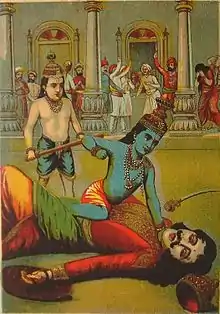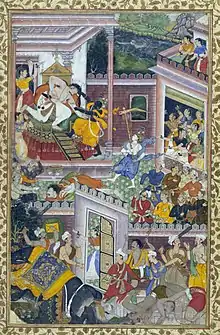Kamsa
In Hindu tradition, Kamsa (Sanskrit: कंसः, IAST: Kamsa, also transliterated as Kansa) was the tyrant ruler of the Vrishni kingdom with its capital at Mathura. He was the cousin of Devaki, the mother of the god Krishna — who slew Kamsa. Kamsa is described as human in early sources and a rakshasa (demon) in the Puranas.[1][2][3] His royal house was called Bhoja and another of his names was Bhojapati.[4]
| Kamsa | |
|---|---|
 Krishna kills Kansa | |
| In-universe information | |
| Family | Ugrasena (father) Padmavati (mother) |
| Spouse | Asti and Prapti (daughters of Jarasandha) |
| Relatives | |
| Royal house | Bhoja Yadav |
Kamsa was born to King Ugrasena and Queen Padmavati. However, out of ambition and upon the advice of his personal confidantes, Banasura and Narakasura, Kamsa decided to overthrow his father and install himself as the King of Mathura. Therefore, upon the guidance of another advisor, Chanur, Kamsa decided to marry Asti and Prapti, the daughters of Jarasandha, King of Magadha.[5]
After a heavenly voice prophesied that Devaki's eighth son will slay him, he imprisoned Devaki and her husband Vasudeva and killed all their children; however Just before the birth of the seventh child of Devaki and Vasudeva, Lord Vishnu ordered Goddess Mahamaya to transfer the womb of Devaki to that of Rohini, another wife of Vasudeva. Soon, Rohini gave birth to Devaki's seventh son, named Balarama. The eighth son, Krishna, an avatar of the god Vishnu, was transported to Gokul, where he was raised in the care of Nanda, the head of cowherds. Kamsa sent a host of demons to kill the child Krishna, all of whom Krishna killed. Finally, Krishna arrived in Mathura and slew his uncle Kamsa.[6]
Birth
In reality, Kamsa was not the biological son of Ugrasena. Once a Gandharva with powers to read the minds was wandering, Ugrasena's wife was having sexual thoughts for her husband. Gandharva, able to read her mind transformed into Ugrasena and participated in the act with her. Ugrasena's wife realized that he was not Ugrasena which led to the Gandharva revealing his true form. Gandharva tells about the power of the child who is going to take birth, describing this child being between a human and a Gandharva, however, an angered Ugrasena's wife in rage curses the child to become the ill-named Rakshasa. Gandharva fearing the curse being directed at him adds to the curse and even he curses the child that he will be troubled by his own and flees the place. In fact, Kamsa in his previous birth was a demon called Kalanemi, who was slain by Lord Vishnu.[7]
In childhood, Kamsa was trained by the other Yadavas, who were famous warriors, along with his eight brothers.[8] Kamsa acquired Jarasandha's attention when the latter tried to invade Mathura. Kamsa single-handedly routed Jarasandha's army. The latter was impressed and made Kamsa his son-in-law. With Jarasandha's support, Kamsa became even more powerful.
Annexation of kingdom
During his wedding in Mathura, Jarasandha brought over his army to escort the Princesses Asti and Prapti. Using the army of Magadha as his political cover, Kamsa overthrew his father after he refused to voluntarily retire from his position. This was done within the confines of the royal palace and the public was not informed. After Ugrasena failed to show up for public events, Kamsa announced his coronation.[9]
Warning issued by Yogmaya
.jpg.webp)
In a prophecy, Kamsa was told that the eighth child of Devaki will kill him. Hearing that, he wanted to kill Devaki, but Vasudeva managed to save her life by promising Kamsa that he (Vasudeva) himself will deliver all their children to Kamsa. Kamsa accepted that promise and spared Devaki because she herself was not a threat to him. In the confines of the prison, Devaki repeatedly conceived and Kamsa cruelly murdered the first six children.[10]
Just before the seventh child was born, Lord Vishnu ordered Goddess Mahamaya (beautiful goddess and the controller of Maya) to place the seventh child of Devaki in the womb of Rohini. Thus, facilitating God Sesha's descent or avatar, the seventh child was raised by surrogate mother, Rohini, and was named Balarama, Shri Krishna's elder brother. Whereas Lord Shri Hari-Vishnu Himself, was soon to appear as the eighth son of Devaki, he ordered Yogamaya to take birth from the womb of Yashoda. Facilitating God Vishnu's descent or avatar, Yogmaya (the controller of the darkness and ignorance) had put the guards of Kamsa to sleep or a state of trance. At that time also, Vasudev, obeying Shri Hari's order, took Bal Krishna to Nand- Yashoda's house, bringing back the Baby girl, Yogmaya. Presuming this baby as Devaki's eighth child, Kamsa was about to kill her by slamming her down on the ground, but the girl slipped out of his hands. Taking her cosmic form, Yogamaya warned Kamsa, "The eighth child, who shall kill you, has been born. He is in Gokul!"[11]
Death

The seventh child, Balarama, was saved when he was moved to Rohini's womb. The eighth child born to Devaki and Vasudeva was Krishna. Krishna was saved from Kamsa's wrath and raised by Vasudeva's relative Nanda and Yasoda, a cowherd couple.[12]
After Krishna grew up and returned to the kingdom, Kamsa was eventually killed by Krishna, as was originally predicted by the divine prophecy. Krishna kicked Kamsa on the chest and put his foot on him, thus killing him. His eight brothers, headed by Kanka, were also killed by Balarama. Following this, Ugrasena was reinstated as the King of Mathura.[13]
Notes
- George M. Williams (27 March 2008). Handbook of Hindu Mythology. Oxford University Press. p. 178. ISBN 978-0-19-533261-2.
- John Stratton Hawley; Donna Marie Wulff (1982). The Divine Consort: Rādhā and the Goddesses of India. Motilal Banarsidass. p. 374. ISBN 978-0-89581-102-8.
- Aiyangar Narayan (1901). Essays On Indo-Aryan Mythology-Vol. Asian Educational Services. p. 503. ISBN 978-81-206-0140-6.
- Gopal, Madan (1990). K.S. Gautam (ed.). India through the ages. Publication Division, Ministry of Information and Broadcasting, Government of India. p. 78.
- F. S. Growse. Mathura-Brindaban-The Mystical Land Of Lord Krishna. Diamond Pocket Books (P) Ltd. p. 70. ISBN 9788171824434.
- B. K. Chaturvedi. Shrimad Bhagwat Purana. Diamond Pocket Books (P) Ltd. pp. 85–86. ISBN 9788171828319.
- J.P. Mittal (2006). History Of Ancient India, A New Version: From 4250 BC to 637 AD. Atlantic Publishers & Dist. p. 428. ISBN 9788126906161.
- https://vaniquotes.org/wiki/Kamsa_had_eight_brothers,_headed_by_Kanka,_all_of_them_younger_than_he,_and_when_they_learned_that_their_elder_brother_had_been_killed,_they_combined_together_and_rushed_toward_Krsna_in_great_anger_to_kill_Him
- James Talboys Wheeler (2010). The History of India from the Earliest Ages: Hindú, Buddhist, and Brahmanical revival. N. Trübner & Company. p. 377.
- Alo Shome, Bankim Chandra Chattopadhyaya (2011). Krishna Charitra. V&S Publishers. p. 33. ISBN 9789381384879.
- Dev Prasad (2010). Krishna: A Journey through the Lands & Legends of Krishna. Jaico Publishing House. ISBN 9788184951707.
- Alo Shome, Bankim Chandra Chattopadhyaya (2011). Krishna Charitra. V&S Publishers. p. 48. ISBN 9789381384879.
- Alo Shome, Bankim Chandra Chattopadhyaya (2011). Krishna Charitra. V&S Publishers. p. 52. ISBN 9789381384879.
References
- Dictionary of Hindu Lore and Legend (ISBN 0-500-51088-1) by Anna Dhallapiccola
External links
| Wikimedia Commons has media related to Kamsa. |

